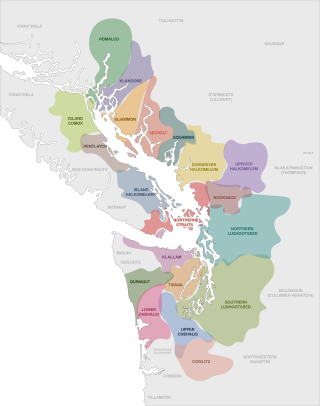
The Coast Salish languages, also known as the Central Salish languages, are a branch of the Salishan language family. These languages are spoken by First Nations or Native American peoples inhabiting the Pacific Northwest, in the territory that is now known as the southwest coast of British Columbia around the Strait of Georgia and Washington State around Puget Sound. The term "Coast Salish" also refers to the cultures in British Columbia and Washington who speak one of these languages or dialects.
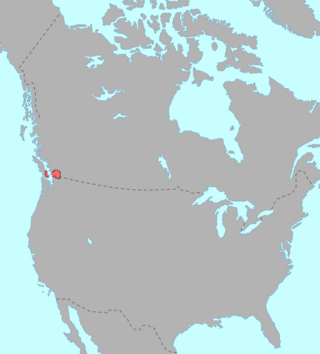
Halkomelem is a language of various First Nations peoples of the British Columbia Coast. It is spoken in what is now British Columbia, ranging from southeastern Vancouver Island from the west shore of Saanich Inlet northward beyond Gabriola Island and Nanaimo to Nanoose Bay and including the Lower Mainland from the Fraser River Delta upriver to Harrison Lake and the lower boundary of the Fraser Canyon.

The Stó꞉lō, alternately written as Sto꞉lo, Stó꞉lô, or Stó꞉lõ, historically as Staulo, Stalo or Stahlo, and historically known and commonly referred to in ethnographic literature as the Fraser River Indians or Lower Fraser Salish, are a group of First Nations peoples inhabiting the Fraser Valley and lower Fraser Canyon of British Columbia, Canada, part of the loose grouping of Coast Salish nations. Stó꞉lō is the Halqemeylem word for "river", so the Stó꞉lō are the river people. The first documented reference to these people as "the Stó꞉lō" occurs in Catholic Oblate missionary records from the 1880s. Prior to this, references were primarily to individual tribal groups such as Matsqui, Ts’elxweyeqw, or Sumas.

Wakashan is a family of languages spoken in British Columbia around and on Vancouver Island, and in the northwestern corner of the Olympic Peninsula of Washington state, on the south side of the Strait of Juan de Fuca.
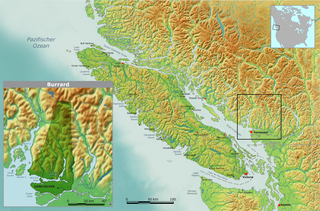
The Tsleil-Waututh Nation, formerly known as the Burrard Indian Band or Burrard Inlet Indian Band, is a First Nations band government in the Canadian province of British Columbia. The Tsleil-Waututh Nation ("TWN") are Coast Salish peoples who speak hən̓q̓əmin̓əm̓, the Downriver dialect of the Halkomelem language, and are closely related to but politically and culturally separate from the nearby nations of the Sḵwx̱wú7mesh (Squamish) and xʷməθkʷəy̓əm (Musqueam), with whose traditional territories some claims overlap.

The Musqueam Nation is a First Nation whose traditional territory encompasses the western half of what is now Greater Vancouver, in British Columbia, Canada. It is governed by a band council and is known officially as the Musqueam Indian Band under the Indian Act. "Musqueam" is an anglicization of the Hunquminum name xʷməθkʷəy̓əm, which means "place of the river grass" or "place where the river grass grows".

Quamichan is a traditional nation of the Coast Salish people, commonly referred to by the English adaptation of Quʼwutsun as the Cowichan Indians, or First Nations, of the Cowichan Valley on Vancouver Island, in the area near the city of Duncan, British Columbia and Salt Spring Island, British Columbia.
The Penelakut First Nation is the band government of the Penelakut people on Vancouver Island in British Columbia, Canada.

The Halalt First Nation is a First Nations tribe located on a reservation on the Chemainus River in southeastern Vancouver Island, British Columbia, Canada. The Halalt were originally from the village xeláltxw once located in the Cowichan Valley, and likely moved to Willy Island, the largest of the Shoal Islands, in the early 19th century.
Malahat First Nation is a Coast Salish First Nations community of W̱SÁNEĆ representing approximately 350 members with two reserve lands located on the western shore of Saanich Inlet, Vancouver Island in British Columbia, Canada. The Malahat First Nation is one of many nations within the Coastal Salish group that live on their traditional lands. The Coastal Salish are Indigenous to the Northwest mainland, coast, and islands. The Malahat First Nation is a member nation of the Naut'sa mawt Tribal Council and was the ninth First Nation in Canada to be certified by the First Nations Financial Management Board. The ancestral languages of Malahat Nation are Hul̓q̓umín̓um̓ and SENĆOŦEN. The Hul̓q̓umín̓um̓ or Halkomelem language is spoken in Washington State and British Columbia and is within the Coastal Salish language family. Currently it is being revitalized, as it is mainly spoken by elders in the community. The Chief of Malahat Nation is George Harry. George served on the council for four years before being elected as Chief on June 10, 2019.
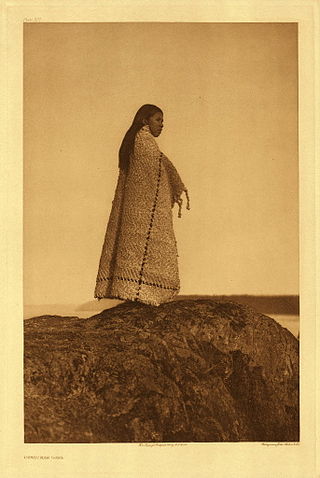
Cowichan Tribes is the band government of the Cowichan, a group of Coast Salish peoples who live in the Cowichan Valley region on Vancouver Island. With over 3,800 registered members, it is the single largest First Nations band in British Columbia.

The Katzie First Nation or Katzie Nation is a First Nation whose traditional territory lies in the Lower Fraser Valley of British Columbia, Canada. According to their oral tradition, the Katzie people are the descendants of the Oe'lecten and Swaneset communities, two of five established by the Creator in present-day Greater Vancouver.
The Matsqui First Nation is the band government of the Matsqui people, a Sto:lo Aboriginal group located in the Central Fraser Valley region, at Matsqui, in the northern part of Abbotsford, British Columbia, Canada. They are a member government of the Sto:lo Nation tribal council.
The Sumas First NationSumalh or Sumas Indian Band is a band government of the Sto:lo people located in the Upper Fraser Valley region, at the community of Kilgard a.k.a. Upper Sumas, part of Abbotsford, British Columbia, Canada. They are a member government of the Sto:lo Nation tribal council.

The Salish peoples are indigenous peoples of the American and Canadian Pacific Northwest, identified by their use of the Salishan languages which diversified out of Proto-Salish between 3,000 and 6,000 years ago.

The History of the Coast Salish, a group of Native American ethnicities on the Pacific coast of North America bound by a common culture, kinship, and languages, dates back several millennia. Their artifacts show great uniformity early on, with a discernible continuity that in some places stretches back more than seven millennia.
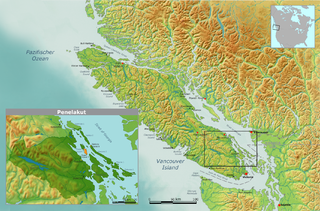
The Hwlitsum First Nation is an organization representing the group historically known as the Lamalchi or Lamalcha but properly called Hwlitsum. The Hwlitsum are the descendants of the Lamalchi people and changed their name to Hwlitsum when they moved to Hwlitsum in 1892. Hul'qumi'num custom names groups based on the location of their winter village. Changing location of their winter village changed the name of the people. The Hwlitsum are a Hulquminum-speaking people whose home region is in the Southern Gulf Islands. The Hwlitsum were never granted reserves or band status and are currently seeking recognition as a band government from the governments of British Columbia and Canada.
Brian Thom is a Canadian anthropologist, former land claims negotiator and Indigenous title, rights and governance advisor.












